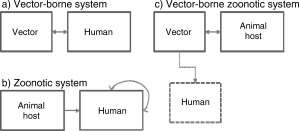Figure 1.

Human disease systems involving (a) vector‐borne (e.g., malaria), (b) zoonotic, and (c) vector‐borne zoonotic pathogens. Lines denote pathogen transmission. Double‐ended arrows denote bidirectional transmission. In panel (b), humans are infected through direct contact with wild or domestic animals and do not generally reinfect these reservoir hosts but may be infectious to other humans (i.e., severe acute respiratory syndrome [SARS]). In the system depicted in panel (c), humans are not important to pathogen persistence or transmission but may be infected if exposed to the vector (i.e., Lyme, West Nile virus [WNV]).
